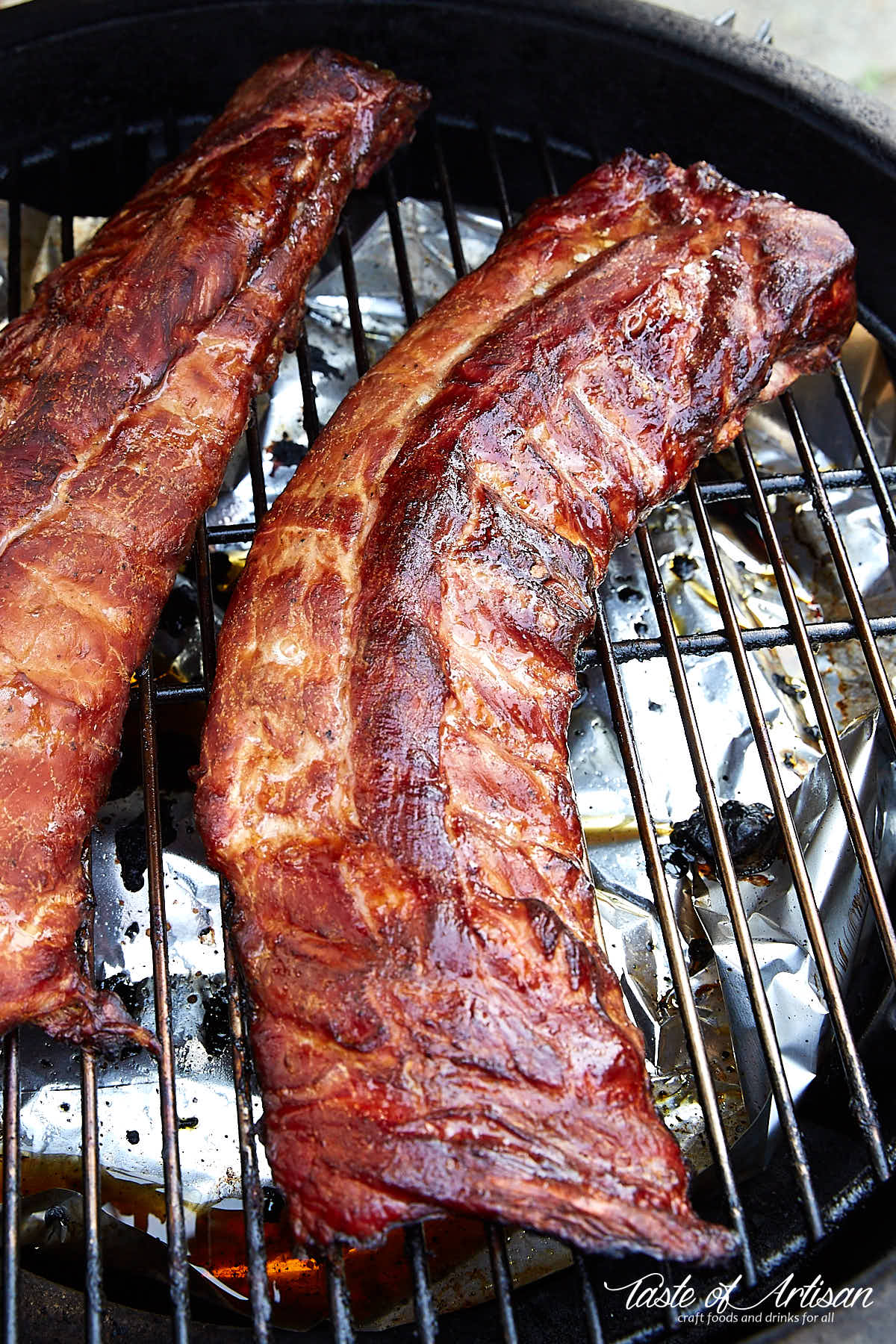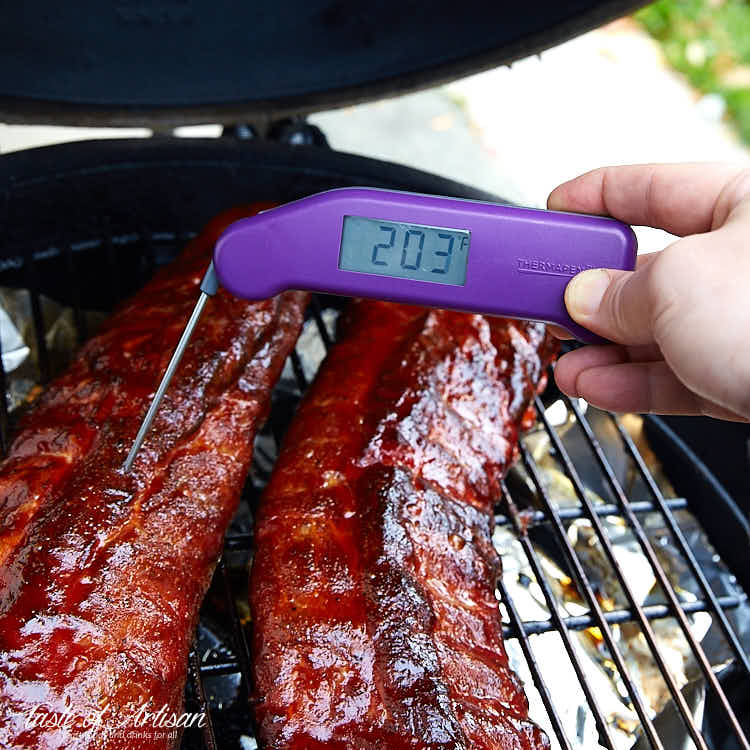Price of Smokey Bones 2.5 Pounds of Baby Back Ribs?

At that place are dozens of ways to cook baby back ribs and I've tried quite a few. The results varied from good to nifty. Just there is 1 that really stands out for me - it's smoking. Smoking infant dorsum ribs gives them that perfect combination of unique texture, bark, captivating colour and the smoky flavour that but can't exist replicated past any other cooking method. Smoking takes a flake of fourth dimension, but really, who cares in the finish.
I like my smoked baby back ribs leaner, firmer and not mushy, with a dainty bark and a perfectly caramelized coat of charcoal-broil sauce. The cease result is what some telephone call pig candy. I don't make them overly sweet though and use a very moderate amount of dark-brown sugar in the rub.
The meat
Depending on where you lot purchase your baby back ribs, they may have more or less meat and fat on them. Both are nifty choices, only difference is that the thicker, meatier racks will melt longer. I do like to trim off equally much fat equally possible. Greasy, fat dripping ribs are merely not my thing. Some say that a layer of fat keeps the meat moist, but that has not been an issue for me. If anything, the fat prevents the smoke from penetrating the meat, which is undesirable.
Don't forget to remove the membrane from the dorsum of the rack, it will better the enjoyment of the meat later.
The rub
The kind of rub people use for smoked pork ribs seems to be a very personal thing. I am no exception. I prefer very mild tasting rubs that don't overpower the flavor of the meat and add merely little flake of kick. The amount of the rub I apply is very minimal. This makes the ribs taste like great charcoal-broil meat, not spices. Some of the best barbecue joints in Texas I was fortunate to visit don't put any spices on their meats at all, just common salt.
I've used the formula shown below for years and don't feel the need to alter it as everyone likes it a lot. Some people specifically asked me not to mess with it.
My rib rub formula:
- kosher common salt - iv tsp
- brownish sugar - 2 Tbsp
- freshly ground black pepper - 1/2 tsp
- onion pulverization - 1 Tbsp
- garlic pulverisation - 2 tsp (sometimes I use pressed fresh garlic and it'south a not bad substitution)
- cayenne pepper - 1/2 tsp (double if you want a little more heat)
The amounts to a higher place are for 2 full pork rib slabs, with both sides of a slab seasoned. Cut in half if seasoning simply the meat side.
In the by I used oil or mustard before applying the rub to make certain information technology sticks properly. Present I successfully use the rub directly to the meat. The surface of the meat is wet so the rub has no problem sticking to it. The way I apply the rub is to sprinkle information technology evenly across the surface of the slab and and so pat downwardly to make sure it sticks. Make sure your hands are dry otherwise you will end upwardly with heavily seasoned hands. I apply the rub to both the meaty side and the back side of the slab.
Once the rub is applied the ribs are fix to go in the smoker. You can as well prepare the meat in advance and refrigerate until you are ready. I often fix and season the slabs the night before and find that it only benefits the meat as the seasonings have the time to get distributed more than evenly. Afterwards an overnight refrigeration you will see that some liquid came out of the meat. Gently pat the slabs dry with a paper towel before putting them in the smoker.
Smoking
The smoker
Over years I've used a number of different smokers and grills to smoke baby dorsum ribs. They all tin be used successfully, but there are some differences to keep in mind. Electric and propane grills and smokers piece of work but lack the depth of flavour that charcoal smokers produce. Propane smokers run drier then you need to account for that by placing a tray of water nether the meat. Charcoal grills/smokers produce the best flavor and don't dry out out the meat virtually as much, but require a picayune more tending and skill to operate them.
The temperature
Whatever grill or smoker y'all use, the virtually important thing is to keep the temperature stable within the desired range. Anywhere betwixt 225F and 250F is perfect. If you become over 250F wet loss accelerates dramatically and melted fatty starts to leave the meat rapidly, resulting in dry final product. The ribs should be smoked over indirect heat, this is important.
I typically smoke infant dorsum ribs at 240F-250F. The reason for the higher end of the range is that, in my subjective opinion, I get meliorate colour and softer texture of the meat. The cooking fourth dimension shortens besides, which is great.
The Texas Crutch
Anyone who is familiar with smoking meats has probably heard of the Texas Crutch. Information technology'due south a method of wrapping meat in foil for a flow of fourth dimension during the smoking process to speed upwardly cooking and reach more than tender meat. It's frequently used in BBQ competitions. Some like it, some don't because the benefit is insignificant compared to some significant downsides. The biggest downside is that this method tin seriously damage the bark, the fume flavor and the seasonings. And if you are not perfect with your timing, you will end upwardly with a slab of mush. I attempted this method with pork ribs several times and never liked the results. The flavor profile was sub-par and the meat lacked the texture I was looking for. It was too soft and more fatty. So I don't wrap.
The barbecue wood
Finally, a few words about the barbecue wood. At that place are several varieties perfectly suitable for smoking baby dorsum ribs, from alder and maple to pecan and mesquite. Some are milder, some are very strong and may overpower the meat if smoking for too long. My personal all-time favorite is crimson wood. Blood-red wood smoke is considered balmy and y'all tin't over smoke with information technology too easily. What I similar the most about this wood is the beautiful rich dark crimson colour it gives the food and the fruity, sweetness smoky flavor. I usually have the smoke going for a skillful 3 hours and this gives me the all-time results.

Checking for doneness
Thinner racks are typically done in near 3.5 hours, while thicker ones may take up to 5.5 hours. Information technology's critical not to overcook them. Information technology's better to check a little early than too late.
There are several ways to check ribs for doneness. The simplest one is the curve test. Selection upward a slab with a pair of tongs and give information technology a gentle bounce. The meat is washed if it cracks on the surface.

Just to be sure, cheque every slab. In my propane smoker the temperature at the top shelf would always be higher and the meat there would cook faster. What I would practise to account for that is to switch the meat out between the shelves in the middle of the cooking process. Even if you cook all your slabs on the same level, hot and cold spots may touch on doneness.
My preferred way to cheque for doneness is the curve test followed past checking the temperature with an instant read thermometer. Some gurus say that there is no sense in using a thermometer equally the meat is too sparse and the thickness varies from end to the eye. Fair enough. My feel is somewhat different though. I observe that I get the best results if the meat reaches effectually 203F tested in the thicker part of the rack, correct between the bones. This way I can as well get predictable and consistent results every time I smoke ribs.

Applying barbecue sauce
This footstep is optional, simply the ribs really benefit from it. One time the ribs are washed, I employ a thick layer of my favorite charcoal-broil sauce over the meat side of the rack. There is not much sense in putting sauce on the back side if the rack as there is no meat at that place. Any BBQ sauce will do. Just option the i y'all like the virtually.

One time the sauce is applied I continue cooking for some other 25-thirty minutes at the same temperature (250F). If you fume at 225F, I suggest increasing the temperature to 250F as the college temperature will help thicken and caramelize the sauce properly.
These additional 25-thirty minutes of cooking will not upshot in overcooked meat as the sauce (assumed to be at a room temperature) will quickly reduce the meat temperature. As the sauce is heating up and caramelizing on the surface, the meat temperature will be going back up. By the time the sauce is nicely thickened the internal temperature of the meat should exist near around the desired target.
stockmanfrict1948.blogspot.com
Source: https://tasteofartisan.com/smoked-baby-back-ribs/
0 Response to "Price of Smokey Bones 2.5 Pounds of Baby Back Ribs?"
Post a Comment